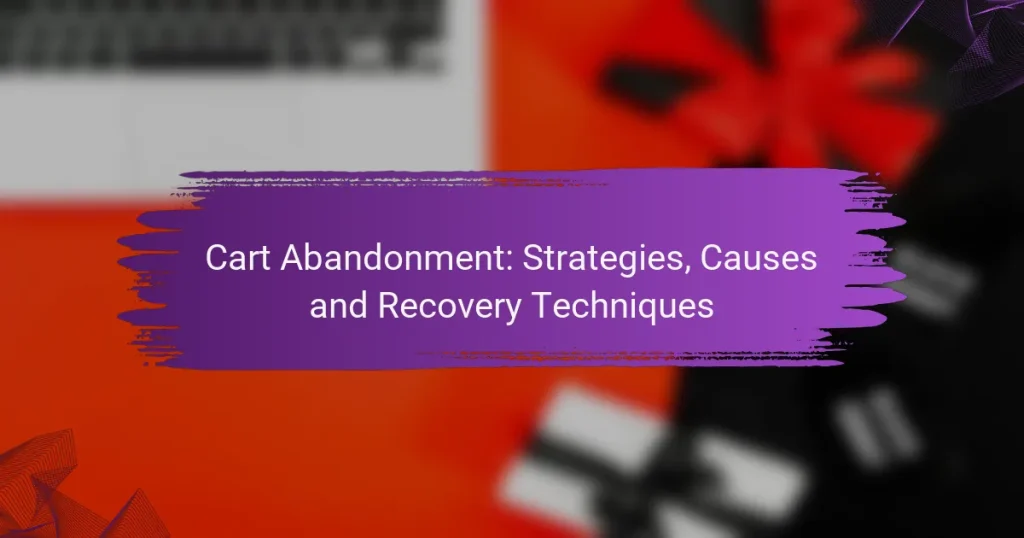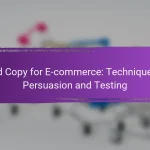Cart abandonment is a significant challenge in e-commerce, where potential customers leave items in their shopping carts without completing their purchases. By understanding the underlying causes and implementing targeted strategies, businesses can effectively reduce abandonment rates and enhance the customer experience. Techniques such as personalized reminders, streamlined checkout processes, and engaging recovery methods can significantly improve conversion rates and drive sales.

What are the best strategies to reduce cart abandonment in e-commerce?
To effectively reduce cart abandonment in e-commerce, businesses should implement targeted strategies that address customer concerns and streamline the purchasing process. Key approaches include personalized email reminders, a streamlined checkout process, exit-intent popups, free shipping offers, and accessible customer support.
Personalized email reminders
Sending personalized email reminders can significantly decrease cart abandonment rates. These emails should be timely, ideally sent within a few hours after the cart is abandoned, and include a friendly reminder of the items left behind.
Including incentives, such as a small discount or free shipping, can further entice customers to complete their purchase. Personalization, such as addressing the customer by name and showcasing the specific products they left in their cart, enhances engagement.
Streamlined checkout process
A streamlined checkout process is crucial for minimizing cart abandonment. Simplifying the steps required to complete a purchase can significantly improve conversion rates. Aim for a one-page checkout or reduce the number of fields customers must fill out.
Consider offering guest checkout options to avoid forcing users to create an account. Additionally, providing multiple payment options, including popular digital wallets, can cater to a wider audience and enhance user experience.
Exit-intent popups
Exit-intent popups are effective tools for capturing potential customers just before they leave the site. These popups can offer discounts, free shipping, or other incentives to encourage users to stay and complete their purchase.
Ensure that the popups are visually appealing and not intrusive, as overly aggressive tactics can frustrate users. Timing and relevance are key; the popup should appear when the user shows signs of leaving, such as moving the cursor toward the browser’s close button.
Free shipping offers
Offering free shipping is one of the most effective strategies to reduce cart abandonment. Many customers abandon their carts due to unexpected shipping costs, so clearly advertising free shipping thresholds can motivate them to complete their purchase.
Consider implementing a minimum purchase requirement for free shipping, which can also increase average order value. Highlighting this offer prominently on product pages and during checkout can reinforce its importance to customers.
Customer support accessibility
Accessible customer support can alleviate concerns that lead to cart abandonment. Providing multiple channels for support, such as live chat, email, and phone assistance, ensures customers can easily get help when needed.
Make sure support options are visible during the checkout process. Quick responses to inquiries can build trust and encourage customers to finalize their purchases, reducing the likelihood of abandonment.

What are the common causes of cart abandonment?
Cart abandonment occurs when potential customers add items to their online shopping cart but leave the site without completing the purchase. Understanding the common causes can help businesses implement effective strategies to reduce abandonment rates.
High shipping costs
High shipping costs are a significant deterrent for many online shoppers. When customers see unexpected shipping fees that exceed their budget, they often abandon their carts. Businesses should consider offering free shipping on orders above a certain amount or providing transparent shipping cost estimates early in the checkout process.
For example, if the average shipping cost is around 10-15% of the order value, it may be wise to adjust pricing strategies to accommodate these costs and maintain customer interest.
Complicated checkout process
A complicated checkout process can frustrate customers and lead to cart abandonment. If the steps to complete a purchase are lengthy or require excessive information, shoppers may opt to leave rather than continue. Streamlining the checkout process by minimizing the number of steps and allowing guest checkout can enhance user experience.
Consider implementing autofill options and a progress indicator to guide customers through the process efficiently.
Unexpected fees
Unexpected fees, such as taxes or service charges, can catch customers off guard and result in cart abandonment. It’s crucial to disclose all applicable fees upfront, ideally before customers reach the payment stage. This transparency builds trust and reduces the likelihood of customers abandoning their carts due to surprise costs.
Businesses can also consider including these fees in the product pricing to simplify the customer’s decision-making process.
Lack of payment options
A limited range of payment options can hinder customers from completing their purchases. Many shoppers prefer using specific payment methods, such as credit cards, PayPal, or digital wallets. Offering a variety of payment options can cater to diverse customer preferences and increase conversion rates.
Regularly reviewing and updating payment options based on customer feedback can help ensure that the checkout experience meets their needs.
Website performance issues
Website performance issues, such as slow loading times or crashes, can lead to cart abandonment. If a site takes longer than a few seconds to load, customers may become impatient and leave. Optimizing website speed and ensuring reliable hosting can enhance user experience and reduce abandonment rates.
Regular performance testing and monitoring can help identify and resolve issues before they impact potential sales.

How can businesses recover abandoned carts?
Businesses can recover abandoned carts through various strategies that engage customers after they leave the checkout process. Effective recovery techniques include automated follow-up emails, offering discount codes, utilizing retargeting ads, and providing incentives to complete purchases.
Automated follow-up emails
Automated follow-up emails are a direct way to remind customers about their abandoned carts. These emails can be sent within a few hours of abandonment, increasing the likelihood of conversion. Personalizing the email with the customer’s name and the items left in the cart can enhance engagement.
Consider including a clear call-to-action (CTA) that directs customers back to their cart. A well-timed follow-up can significantly boost recovery rates, often achieving conversion rates in the low double digits.
Discount codes for returning customers
Offering discount codes can entice customers to return and complete their purchases. A small percentage off, such as 10-15%, can be effective in encouraging action without heavily impacting profit margins. Make sure to clearly communicate the expiration date of the discount to create urgency.
Additionally, consider segmenting your audience to tailor discounts based on customer behavior or purchase history. This targeted approach can lead to higher conversion rates and foster customer loyalty.
Retargeting ads on social media
Retargeting ads are a powerful tool for reminding potential customers about their abandoned carts. By displaying ads on social media platforms, businesses can keep their products top-of-mind for users who have previously shown interest. These ads can include images of the abandoned items and a direct link back to the cart.
To maximize effectiveness, use eye-catching visuals and compelling copy. Testing different ad formats and messages can help identify what resonates best with your audience, improving overall recovery rates.
Incentives for completing purchases
Incentives such as free shipping or bonus loyalty points can motivate customers to finalize their purchases. Many shoppers abandon carts due to unexpected costs, so eliminating shipping fees can be a game-changer. Clearly highlight these incentives in your follow-up communications.
Offering limited-time incentives can create a sense of urgency, prompting quicker decisions. Ensure that the incentives align with your overall marketing strategy to maintain brand consistency and customer trust.

What metrics should be tracked for cart abandonment?
To effectively address cart abandonment, it’s crucial to track key metrics that reveal customer behavior and identify areas for improvement. The most important metrics include the abandonment rate, time spent in the cart, and recovery rate.
Abandonment rate
The abandonment rate measures the percentage of shoppers who add items to their cart but leave the site without completing the purchase. This metric is calculated by dividing the number of completed transactions by the number of initiated transactions and subtracting that from 100%. A high abandonment rate often indicates issues in the checkout process or customer dissatisfaction.
For e-commerce businesses, a typical abandonment rate can range from 60% to 80%. Factors influencing this rate include unexpected shipping costs, complicated checkout procedures, and lack of payment options. Monitoring this rate over time helps identify trends and potential problem areas.
To reduce the abandonment rate, consider streamlining the checkout process, offering transparent pricing, and providing multiple payment methods. Regularly analyze customer feedback and behavior to pinpoint specific obstacles that may be causing potential buyers to leave their carts.


